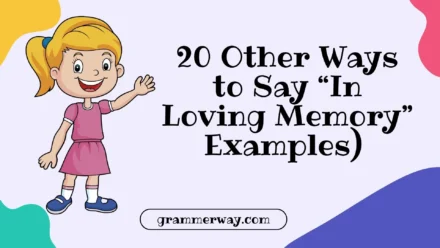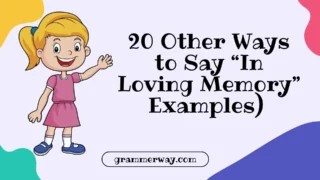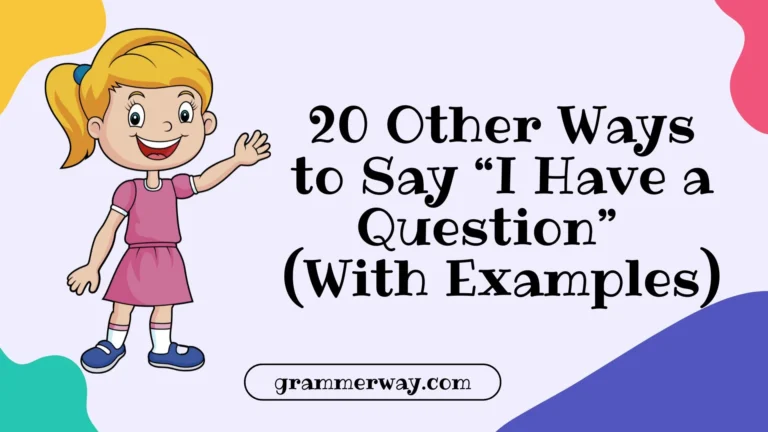Saying “Yes” may seem simple, but the way we agree or show acceptance can greatly change how our message feels. Finding the right words to say yes can express warmth, enthusiasm, and understanding in a more personal and meaningful way. Whether you’re responding to a friend, colleague, or loved one, using different ways to say “yes” can make your communication sound more genuine, confident, and thoughtful. In this article, we’ll explore 20 other ways to say “yes”, with clear meanings, examples, and tones to help you express agreement with care.
What Does “Yes” Mean?
The word “yes” simply means agreement, approval, or acceptance of something. It can express willingness, excitement, confirmation, or permission depending on the tone and situation. Saying “yes” can make others feel heard, respected, and appreciated when used sincerely and thoughtfully.
Is It Professional/Polite to Say “Yes”?
Yes, saying “yes” is both professional and polite when used appropriately. In formal communication, it’s best to pair “yes” with respectful phrases like “Yes, I’d be happy to” or “Yes, that sounds great.” In casual or friendly conversations, softer alternatives can make your responses sound warmer and more human.
Other Ways to Say “Yes”
- Absolutely
- Definitely
- Of course
- Sure thing
- Certainly
- Without a doubt
- For sure
- Sounds good
- You got it
- No problem
- That works for me
- I’d love to
- Gladly
- Consider it done
- All right
- Yup / Yep
- I’m in
- Why not
- Totally
- Affirmative
1. Absolutely
Meaning: Expresses complete agreement with confidence and enthusiasm.
Scenario: When you want to sound supportive and positive in both personal and professional settings.
Examples:
- Absolutely, I’ll take care of that for you today.
- Absolutely, I agree with your plan.
- Absolutely, that sounds perfect to me.
- Absolutely, I’d love to help you out.
- Absolutely, you can count on me for that.
Tone: Confident, positive, and reassuring.
Explanation: Saying “absolutely” shows strong certainty and energy, making your acceptance sound more reliable and enthusiastic.
2. Definitely
Meaning: Shows firm and assured agreement without hesitation.
Scenario: Great for confirming details or showing certainty in casual or work conversations.
Examples:
- Definitely, I think that’s the best idea.
- Definitely, we should go ahead with that plan.
- Definitely, I’ll join you tomorrow morning.
- Definitely, you’re right about that.
- Definitely, I’m available for the meeting.
Tone: Assured, friendly, and clear.
Explanation: “Definitely” communicates that you’re fully on board and confident about your decision.
3. Of Course
Meaning: Indicates agreement with warmth and natural willingness.
Scenario: Best used when agreeing kindly with someone you know well or want to reassure.
Examples:
- Of course, I’ll help you with that.
- Of course, that makes perfect sense.
- Of course, you’re welcome anytime.
- Of course, I completely understand.
- Of course, I’ll be there for you.
Tone: Warm, understanding, and polite.
Explanation: “Of course” adds emotional depth, making your yes sound genuine and considerate.
4. Sure Thing
Meaning: A casual and friendly way to agree or say yes.
Scenario: Great for informal conversations with friends, coworkers, or customers.
Examples:
- Sure thing, I’ll handle that right now.
- Sure thing, I’ll send you the file.
- Sure thing, I’ll meet you after lunch.
- Sure thing, I’m on it.
- Sure thing, no worries at all.
Tone: Casual, approachable, and cheerful.
Explanation: “Sure thing” creates an easygoing tone that feels cooperative and relaxed.
5. Certainly
Meaning: A formal and polite way to say yes.
Scenario: Best used in professional or respectful settings.
Examples:
- Certainly, I’ll schedule that appointment.
- Certainly, I can assist you with that.
- Certainly, that’s a great suggestion.
- Certainly, I’ll get back to you soon.
- Certainly, I appreciate your input.
Tone: Polite, professional, and respectful.
Explanation: “Certainly” helps you sound courteous while maintaining professionalism.
6. Without a Doubt
Meaning: Expresses strong confidence and unwavering agreement.
Scenario: Ideal for showing complete trust or support.
Examples:
- Without a doubt, you’re right about that.
- Without a doubt, I’ll be there on time.
- Without a doubt, this is the right choice.
- Without a doubt, you’ve earned it.
- Without a doubt, I’m ready to begin.
Tone: Firm, sincere, and supportive.
Explanation: Saying “without a doubt” reinforces conviction and reliability in your agreement.
7. For Sure
Meaning: A relaxed and easygoing way to confirm agreement.
Scenario: Common in casual chats or friendly discussions.
Examples:
- For sure, I’ll be there later.
- For sure, that’s totally fine with me.
- For sure, you can rely on me.
- For sure, that’s the plan.
- For sure, we’ll get it done.
Tone: Friendly, upbeat, and casual.
Explanation: “For sure” feels natural and sincere, often used in friendly, laid-back settings.
8. Sounds Good
Meaning: Expresses approval or agreement in a simple and positive way.
Scenario: Best for everyday use in conversations or messages.
Examples:
- Sounds good, let’s meet at 3 PM.
- Sounds good, I’ll bring the snacks.
- Sounds good, I’ll handle the design part.
- Sounds good, I’m on board.
- Sounds good, I’ll confirm the plan.
Tone: Casual, clear, and agreeable.
Explanation: “Sounds good” gives a positive yet calm vibe, ideal for relaxed interactions.
9. You Got It
Meaning: Confidently confirms you’ll do something or agree with someone.
Scenario: Great for expressing readiness and assurance.
Examples:
- You got it, I’ll take care of it.
- You got it, I’m on the way.
- You got it, no need to worry.
- You got it, I’ll send it today.
- You got it, I’ll be there soon.
Tone: Energetic, supportive, and reassuring.
Explanation: “You got it” makes your yes sound like a promise backed with confidence.
10. No Problem
Meaning: Indicates agreement and ease in accepting a request.
Scenario: Commonly used when helping someone or responding positively.
Examples:
- No problem, I’ll handle that.
- No problem, I’ll fix it for you.
- No problem, I can take care of it.
- No problem, it’s my pleasure.
- No problem, that’s easy enough.
Tone: Relaxed, friendly, and helpful.
Explanation: “No problem” suggests willingness and calmness, making you sound approachable.
11. That Works for Me
Meaning: Shows that you agree with or accept a suggestion.
Scenario: Ideal for planning or confirming schedules.
Examples:
- That works for me, let’s do it.
- That works for me, I’ll mark my calendar.
- That works for me, I’m flexible.
- That works for me, see you then.
- That works for me, thanks for checking.
Tone: Cooperative, adaptable, and easygoing.
Explanation: “That works for me” expresses agreement while keeping the tone professional or friendly.
12. I’d Love To
Meaning: Enthusiastic and heartfelt acceptance.
Scenario: Great for invitations or emotional connections.
Examples:
- I’d love to join you for dinner.
- I’d love to help with that project.
- I’d love to see you soon.
- I’d love to participate in the event.
- I’d love to learn more about it.
Tone: Warm, caring, and excited.
Explanation: “I’d love to” adds a personal and emotional touch to your “yes.”
13. Gladly
Meaning: Expresses cheerful willingness or joy in agreeing.
Scenario: Best used when offering help or kindness.
Examples:
- Gladly, I’ll help you out.
- Gladly, I’ll handle that for you.
- Gladly, I’ll join the meeting.
- Gladly, I’ll assist with the task.
- Gladly, I’ll support your idea.
Tone: Joyful, supportive, and positive.
Explanation: “Gladly” conveys genuine happiness in agreeing to do something.
14. Consider It Done
Meaning: Strong expression of commitment and confidence.
Scenario: Best for professional or confident responses.
Examples:
- Consider it done, I’ll take care of it immediately.
- Consider it done, you can count on me.
- Consider it done, I’ll finalize the details.
- Consider it done, I’ll make it happen.
- Consider it done, leave it to me.
Tone: Professional, firm, and reliable.
Explanation: “Consider it done” communicates efficiency and confidence in your yes.
15. All Right
Meaning: Indicates acceptance or mild agreement.
Scenario: Suitable for informal situations.
Examples:
- All right, let’s go for it.
- All right, that sounds good.
- All right, I’ll do it now.
- All right, I understand.
- All right, count me in.
Tone: Neutral, relaxed, and accepting.
Explanation: “All right” is casual but clear, ideal for everyday responses.
16. Yup / Yep
Meaning: Informal and cheerful versions of “yes.”
Scenario: Perfect for casual or friendly chats.
Examples:
- Yep, I agree with you.
- Yup, that’s exactly right.
- Yep, I’ll join you later.
- Yup, I’m already working on it.
- Yep, all set from my side.
Tone: Playful, casual, and light-hearted.
Explanation: “Yep” or “Yup” adds friendliness and ease to your agreement.
17. I’m In
Meaning: Shows willingness to participate or be part of something.
Scenario: Great for group plans or team settings.
Examples:
- I’m in, let’s make it happen.
- I’m in, that sounds fun.
- I’m in, count me for the project.
- I’m in, I like the idea.
- I’m in, totally ready for this.
Tone: Enthusiastic, motivated, and team-oriented.
Explanation: “I’m in” expresses excitement and readiness to join or agree.
18. Why Not
Meaning: Casual acceptance showing openness to an idea.
Scenario: Perfect for spontaneous or relaxed discussions.
Examples:
- Why not, let’s give it a try.
- Why not, that could be fun.
- Why not, I’m open to it.
- Why not, sounds interesting.
- Why not, let’s see how it goes.
Tone: Curious, open-minded, and easygoing.
Explanation: “Why not” conveys lighthearted agreement and a willingness to explore.
19. Totally
Meaning: Expresses full agreement or excitement.
Scenario: Used in casual speech to emphasize enthusiasm.
Examples:
- Totally, I agree with that.
- Totally, you nailed it.
- Totally, I’m ready to go.
- Totally, that’s my thought too.
- Totally, count me in.
Tone: Energetic, youthful, and affirming.
Explanation: “Totally” makes your yes sound expressive and full of energy.
20. Affirmative
Meaning: Formal and direct confirmation, often used in professional or military settings.
Scenario: Suitable for technical, structured, or serious communication.
Examples:
- Affirmative, I have received the message.
- Affirmative, the task is completed.
- Affirmative, I understand the instructions.
- Affirmative, the report is ready.
- Affirmative, everything is on track.
Tone: Formal, precise, and authoritative.
Explanation: “Affirmative” is a clear and confident confirmation, often used in professional contexts.
Conclusion
Using different ways to say “yes” helps you express yourself more naturally and meaningfully. From “absolutely” to “I’d love to”, each phrase carries its own tone, making your communication sound more genuine, polite, or enthusiastic. Whether you’re speaking casually or professionally, choosing the right alternative can make your agreement feel more personal and thoughtful.
FAQs
1. What’s the most polite way to say yes in business communication?
“Certainly” or “Absolutely” are polite, confident, and professional ways to say yes.
2. Which informal alternatives to yes sound friendly?
“Sure thing,” “For sure,” and “Sounds good” are great casual options.
3. How can I make my yes sound more enthusiastic?
Use words like “I’d love to,” “Absolutely,” or “Totally” to show excitement.
4. What’s a professional way to agree in email?
Try “That works for me” or “Consider it done” for clear and confident replies.
5. What’s a simple yet positive way to say yes daily?
“Sounds good” and “For sure” are easy and natural everyday phrases.







Leave a Comment